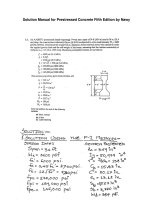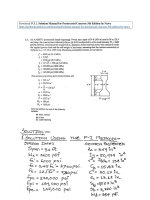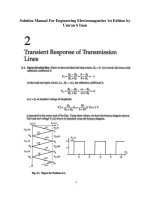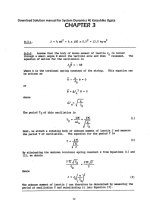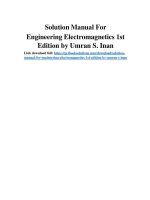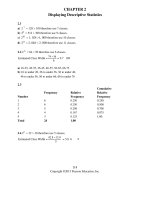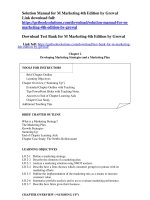link full solution manual for administering medications 7th edition by gauwitz
Bạn đang xem bản rút gọn của tài liệu. Xem và tải ngay bản đầy đủ của tài liệu tại đây (148.88 KB, 3 trang )
Solution Manual for Administering Medications 7th
Edition by Donna F.Gauwitz
C H A P T E R 1: Orientation to Medications
Learning Outcomes
1-1 Define pharmacology, pharmacodynamics, pharmokinetics, anatomy, physiology,
and pathology.
1-2 Define drug, therapeutic effects, and side effects.
1-3 List the major sources of drugs and give examples of each.
1-4 List the seven uses of drugs.
1-5 Define drug standards and tell how they are determined.
1-6 Explain why drug standards are necessary.
1-7 List and describe four types of names by which drugs are known.
1-8 List three drug references and show how to use at least one.
1-9 Use drug references to prepare a drug card.
1-10 List three major drug laws and list their main features.
1-11 List the federal agencies that enforce the drug laws.
1-12 Explain why health care workers must be familiar with drug laws.
Chapter Outline
Key Terms
Introduction to Pharmacology
Pharmacology
Drug Sources
Drug Uses
Drug Standards
Drug Names
Drug References
Preparing Your Own Drug Cards
Drug Legislation
You and the Law
Chapter Summary
Chapter 1 Review
1
Teaching Strategies
Ask students to identify the key terms they are already familiar with. Discuss the
definitions of all the terms and be certain that students are clear about the meanings.
Point out any similarities that may be confusing to them and tell them to memorize
those words to avoid confusion
later on. Ask volunteers to share their methods of
learning medical key terms.
Ask students to list the major sources of drugs and give examples of each.
If possible, obtain a film from the library or
a pharmaceutical company explaining the process
of drug trials. Show the film to the class.
Take a field trip to a pharmaceutical company in your area to observe the step-bystep process of manufacturing drugs. Ask students to summarize why, as health care
workers, they should understand the
drug manufacturing process. Discuss how the
company followed drug legislation.
Invite a pharmacist into class (or visit a pharmacy) to discuss the process
of testing for generic
drugs. Ask students why it is important they understand this process.
Ask a pharmaceutical representative
to speak to the class about how he or she can make a
difference in patient care.
Visit a local pharmacy or invite a pharmacist into class to discuss what pharmacists teach
patients when they dispense a drug. Ask for print material that is sometimes given
to patients.
Discuss in class how this material could be beneficial or harmful to the patient.
When students begin work in a health facility, ask them to make a list of all the drug
references that are available to them in their work environment. Are the materials
up-todate? Why
are up-to-date references important to the patient and the health
care worker?
Ask students to complete the Chapter 1 Review. Discuss answers, clearing up any
misconceptions students may have. Review any material students had difficulty with.
Administer and grade the Chapter 1 Test in this Instructor’s Manual.
Develop and administer a performance test for preparing a drug card.
Critical Thinking Activity
You are admitting a patient who frequently changes physicians. The patient has an
unlabeled bottle of pills that she has been taking. She says that a doctor she no longer sees
prescribed them for her. She does not know why she was taking the drug or the name of the
drug. What should you do to determine the drug’s name, action, and therapeutic purpose?
Answers to Chapter 1 Review
1. Chemical substance used in the diagnosis, treatment, cure, or prevention of a particular
disease
2. The study of drugs: sources, chemical makeup, uses, how to prepare them, and so on
3. The structure of the body and its parts
4. The science that deals with the functions of cells, tissues, and organs of living organisms
5. Rules concerning the strength, quality, and purity of drugs
6. Physicians’ Desk Reference®, a drug reference
7. United States Pharmacopeia/National Formulary, a drug reference containing the standards for
officialdrugs
8. Enforcement agency that enforces the Patriot Improvement and Reauthorization Act of
2005. 9. The absorption, distribution, metabolism, and excretion of drugs
10. Drug sources include:
Plants—digitalis, opium, belladonna, vitamin C, gums, oils
Animals—insulin, heparin
Minerals—iron, iodine, salt, calcium
Synthetic drugs—Bactrim, Septra, biotechnology, Humulin® insulin, vaccines
11. Drug uses:
2
Prevent diseases—vaccines
Maintain health—insulin, vitamins
Diagnose disease—radiopaque dye, barium
Treat disease—aspirin, antihistamines
Cure disease—antibiotics
Prevent pregnancy—contraceptives
Palliative—chemotherapy
12. Drug laws and agencies:
Pure Food and Drug Act of 1906, no agency
Food, Drug, and Cosmetic Act of 1938, enforced by the FDA
Controlled Substances Act of 1990, enforced by the DEA
13. OTC drugs can be bought and sold without a prescription. Prescription drugs need a
doctor’s written
or verbal order to be bought and sold. Controlled substances have restrictions on who can
prescribe,
and how, and how often they can be prescribed.
14. c
15. b
16. a
17. d
18. f
19. e
20. e 21. b
22. a
23. d
24. c
25. b 26. b
27. c.
28. d
29.a
30.
Metamucil is a bulk-forming laxative of plant origin.
Digitalis is a cardiac glycoside used in the treatment of congestive heart failure.
It is also of plant origin.
Insulin is used in the treatment diabetes mellitus. It is of animal source.
Bactrim is a synthetic drug to treat an infection.
Iron is a mineral given as a supplement generally for a deficiency in the diet.
31.
Nitroglycerin is the generic name and Nitrostat is the brand name.
A healthcare provider may order a drug by either a generic or brand name.
A generic name allows the pharmacist to dispense from nonbrand name drugs.
A drug only has one generic drug name but may have several brand names.
For example, nitroglycerin has the other brand names of Nitro-bid or Nitrong.
Although memorizing all the generic and brand names for drugs is not possible, be
familiar with both the generic and brand names.
32.
Janie should study the federal and state laws controlling medication administration. She
should also study the nursing home’s own regulations, and she should find out who is in
charge so that she knows to whom questions should be addressed.
33.
Answers will vary
34.
White
35.
About 17 (this will vary from year to year)
36.
Acetaminophen
37.
Answers will vary
3
